The Tale of the Heike in Text and Animation
by Rebecca Silverman,Once upon a time, most likely before 1330 C.E., a story was written. It told of the clash of the Genji and Taira clans, and while we don't know who first wrote it down, we can certainly trace at least some versions' provenance. The story was written and rewritten, translated and retranslated, until eventually in 2021 Science SARU used it as the basis for their latest anime project. Not that that's meant to indicate that the anime adaptation is the be-all and end-all of The Tale of the Heike versions, but it certainly brings us to the point where you're reading about it on an anime website, so for our purposes, this is an important moment.

So what is The Tale of the Heike, otherwise known as Heike Monogatari? It's a major work of classic Japanese literature, probably dating to the late thirteenth or early fourteenth century, that tells the story of the Taira clan and their struggles to hold on to power. Since “Taira” can also be read “Heike,” that's where the title comes from, but using that name in the title may also be intended to remind readers (or listeners; more on that in a bit) that the events described in the tale took place at the end of the Heian period of Japanese history, which lasted from 794 to 1185 C.E. There's also a nice bit of irony that a story that involves so very many warrior monks and so much violence uses the character for “peace” (hei) in its title. While it can be difficult to point out one specific main actor in the tale, the closest we probably come is Taira no Tokuko, who manages to survive the entire book (although she's not present for every chapter) and closes out the story, praying for the Taira as a whole before dying and being welcomed to the Pure Land. She's not precisely a point-of-view character; rather, she functions more as a waypoint and guide, reminding us that the entire story takes place over one woman's lifetime.
Science SARU's most notable choice in its retelling, therefore, is the addition of a young girl to be our entry into the tale. Biwa, the daughter of a blind biwa player killed by Taira soldiers, is not present in the original text. She's not a completely random character, however – among the surviving texts of The Tale of the Heike, scholars differentiate between “reading” (yomihon) and “performance” (kataribon) versions.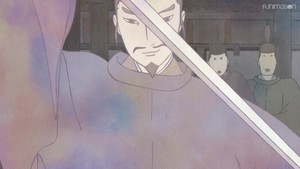 As you can guess, the former is intended for private perusal while the latter is meant to be seen and heard. The best known of the kataribon versions is the 1371 Kakuichi-bon edition, which was performed and dictated to a disciple by Akashi no Kakuichi, a blind biwa performer. Therefore, we can see Biwa's father as being one of the “biwa monks” (performers who traveled wearing Buddhist robes), and perhaps Biwa herself as an ancestor of Akashi no Kakuichi, who passes the story she observed down to her descendants. Since at times we do see what appears to be an old woman with long white hair singing pieces of the story accompanied by her biwa playing, this seems to be what the production is trying to imply.
As you can guess, the former is intended for private perusal while the latter is meant to be seen and heard. The best known of the kataribon versions is the 1371 Kakuichi-bon edition, which was performed and dictated to a disciple by Akashi no Kakuichi, a blind biwa performer. Therefore, we can see Biwa's father as being one of the “biwa monks” (performers who traveled wearing Buddhist robes), and perhaps Biwa herself as an ancestor of Akashi no Kakuichi, who passes the story she observed down to her descendants. Since at times we do see what appears to be an old woman with long white hair singing pieces of the story accompanied by her biwa playing, this seems to be what the production is trying to imply.
Before we go any further, it's worth mentioning that there have been at least five English translations of The Tale of the Heike, with the earliest dating to 1918. The most recent is the 2012 translation by Royall Tyler, based on the Kakuichi-bon edition. Funimation's subtitles (they're streaming the show as a simulcast; two episodes have aired as of this writing) feel relatively close to Tyler's translation at times, particularly during the sung sections. 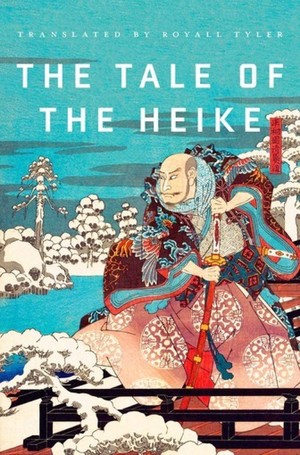 (Those are parts noted as songs in the Tyler text.) What this means is that if you decide to read the story after the anime finishes its run or just to know what the source material is, it will be worth hunting down Tyler's translation, since the textual link will already exist, albeit imperfectly, since there are some more confusing elements present in Funimation's subtitles that could be resolved by sticking closely to Tyler. Tyler's work is also the smoothest of the English translations, and while I hesitate to call the book “readable” in the casual sense, having read two others (the 1975 and the 1988 translations; one reads what one's library has), Tyler's really does feel like the best.
(Those are parts noted as songs in the Tyler text.) What this means is that if you decide to read the story after the anime finishes its run or just to know what the source material is, it will be worth hunting down Tyler's translation, since the textual link will already exist, albeit imperfectly, since there are some more confusing elements present in Funimation's subtitles that could be resolved by sticking closely to Tyler. Tyler's work is also the smoothest of the English translations, and while I hesitate to call the book “readable” in the casual sense, having read two others (the 1975 and the 1988 translations; one reads what one's library has), Tyler's really does feel like the best.
The first two episodes of the animated version cover the first two “books” (sections) of the story. While the text contains a fair amount of flashbacks and historical references, the anime tends to stick to the tale's present, with picture scroll-styled images denoting the flashbacks from the text. This works well, because book one in particular can be very confusing: it hops around in time, and an inordinate number of named characters pop up. The focus is on contrasting Taira no Kiyomori with his son Taira no Shigemori, showing us how the two clash based on their differing ideas of what is right and proper. Kiyomori favors violence and retaliation while Shigemori is calm and reasonable, preferring appeasement. Two scenes in particular highlight this distinction: the murder of Biwa's father at the hands of Kiyomori's men, after which Shigemori takes her into his household, and the incident with Shigemori's second son, who makes a foolish mistake and angers the regent. Shigemori wants the boy to simply apologize, but terming that “weak,” Kiyomori sends out soldiers to humiliate the regent and his men. The result of Kiyomori's angry retaliation is that Shigemori has to send his son into exile for his own safety, something Kiyomori once again feels is a weak action unbecoming of a Taira.
Both of these scenes establish Biwa as our entry into the work. She is both a victim of Kiyomori's wanton cruelties and a recipient of Shigemori's kindness, and that puts her in the perfect position to observe the interplay between father and son and to analyze their differences. 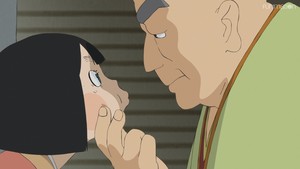 When Biwa first meets Shigemori, she's angry, and ready to take on the entire Taira family because of what was done to her father. But as she spends time in Shigemori's household, interacting with his sons and coming to understand that Shigemori will do whatever he can to ensure her comfort, she sees that not all members of the Taira clan are like the ones who killed her father. Biwa learns to distinguish between right and wrong through observation, starting to see the nuances of power and what it can do to a person.
When Biwa first meets Shigemori, she's angry, and ready to take on the entire Taira family because of what was done to her father. But as she spends time in Shigemori's household, interacting with his sons and coming to understand that Shigemori will do whatever he can to ensure her comfort, she sees that not all members of the Taira clan are like the ones who killed her father. Biwa learns to distinguish between right and wrong through observation, starting to see the nuances of power and what it can do to a person.
We see how she's coming to understand this in her interactions with two women: Tokuko, Shigemori's sixteen-year-old sister, and Gio, a dancer who was once favored by Kiyomori. The story of Gio and her sister Ginyo is among the most famous episodes in The Tale of the Heike, an early glimpse into the capricious nature of Kiyomori and how he has no problems using people and discarding them without a thought. Gio and Ginyo are shirabiyoshi, a type of dancer who dressed in masculine clothing and performed imayo, a popular song style of the period. The two are at first favored by Kiyomori, but when a new dancer looking to make a name for herself shows up, the sisters are dismissed, only being summoned at times to keep the new favorite dancer (who has been taken into Kiyomori's household) entertained. 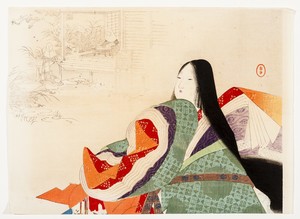 Eventually the sisters and their mother leave the capital and take religious vows; later their rival appears on their doorstep to beg both their forgiveness and their mercy, as she has also escaped Kiyomori by becoming a nun. In the anime, Biwa meets Gio at Kiyomori's home, where the dancer notices Biwa's unusual eyes. This leads to a conversation between them, and Biwa finds comfort in the motherly nature of Gio. When Gio takes her vows, Biwa realizes that sometimes you have to do whatever it takes to secure your own peace of mind and happiness, something she didn't really have a concept of before. But Gio's ability to make her own choices makes Biwa look at how different Tokuko's life is as the daughter of a powerful man, and that may turn out to be the more important aspect of these episodes.
Eventually the sisters and their mother leave the capital and take religious vows; later their rival appears on their doorstep to beg both their forgiveness and their mercy, as she has also escaped Kiyomori by becoming a nun. In the anime, Biwa meets Gio at Kiyomori's home, where the dancer notices Biwa's unusual eyes. This leads to a conversation between them, and Biwa finds comfort in the motherly nature of Gio. When Gio takes her vows, Biwa realizes that sometimes you have to do whatever it takes to secure your own peace of mind and happiness, something she didn't really have a concept of before. But Gio's ability to make her own choices makes Biwa look at how different Tokuko's life is as the daughter of a powerful man, and that may turn out to be the more important aspect of these episodes.
Biwa's unusual heterochromatic eyes are one of the aspects of the story that are unique to the anime, particularly in terms of what they can do. Her blue eye has the ability to see into the future if she covers her brown eye, and this ability both helps her to accept Gio's choices (she sees the dancer's happy future) and makes her fearful for Tokuko's upcoming marriage, as she sees an image of her friend drowning in the sea. Also original to the animated version is Shigemori's own supernatural power. He has one light brown and one dark brown eye, and in his case his lighter-colored eye can see ghosts. 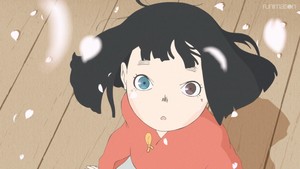 This is how he comes to take Biwa into his household, as he witnesses the ghost of her father hovering behind her, and more frequently he sees the unsettled spirits of the violently deceased. Both Biwa's and Shigemori's powers serve the greater story, or rather, the streamlining of it to better fit the structured nature of an anime series: Biwa foreshadows while Shigemori is our window to the violent past of his father and the human cost of the wars fought at his behest. It also gives Shigemori more of a reason than he necessarily has in the book to be his father's opposite; he can see what war brings in its restless dead and so has to live with the consequences of other peoples' actions.
This is how he comes to take Biwa into his household, as he witnesses the ghost of her father hovering behind her, and more frequently he sees the unsettled spirits of the violently deceased. Both Biwa's and Shigemori's powers serve the greater story, or rather, the streamlining of it to better fit the structured nature of an anime series: Biwa foreshadows while Shigemori is our window to the violent past of his father and the human cost of the wars fought at his behest. It also gives Shigemori more of a reason than he necessarily has in the book to be his father's opposite; he can see what war brings in its restless dead and so has to live with the consequences of other peoples' actions.
The anime feels thus far like a solid adaptation, or as close as we might reasonably expect. It's most successful in its use of colors and the way that it transforms the stylized images that illustrate early versions of the text into a more modern sensibility. This ranges from the use of picture scroll illustrations to little details like showing the individual hairs in a woman's carefully curated dot eyebrows or the sense of weight to the clothing. 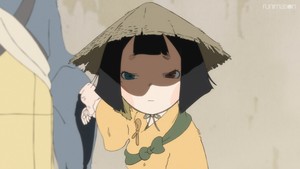 The colors range from rich like new ink to faded, as if the images have aged between scenes, which is remarkably effective. Character designs aren't necessarily “anime pretty,” but they absolutely work for the story and take into account the way the characters are meant to be seen in the source material.
The colors range from rich like new ink to faded, as if the images have aged between scenes, which is remarkably effective. Character designs aren't necessarily “anime pretty,” but they absolutely work for the story and take into account the way the characters are meant to be seen in the source material.
How much of the original work The Tale of the Heike will adapt remains to be seen. Given Shigemori's prominence as a main character, it may only cover the first three sections, but Tokuko's prevalence in these two episodes would make it possible for Biwa to continue to observe the action of the story at her side, or even just as a member of Shigemori's household with his sons. It will be interesting to see what it does and how far it goes, as the bells of the Jetavana Temple ring out over the story of the Taira clan.
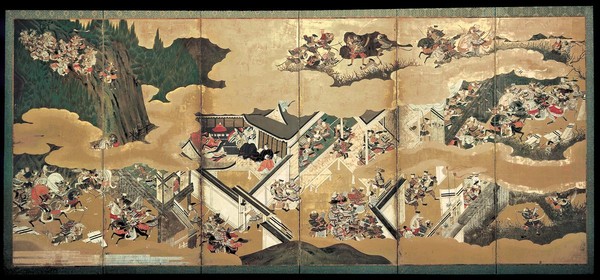
discuss this in the forum (9 posts) |
this article has been modified since it was originally posted; see change history